Browse Primary Sources
Locate primary sources, including images, objects, media, and texts. Annotations by scholars contextualize sources.
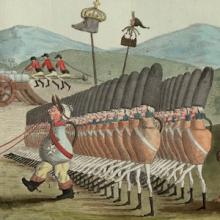
Army of Jugs
This color drawing, produced in 1793 at the request of the Committee of Public Safety and then published as an engraving, caricatures the British army and its king, George III, as incompetent, who, despite fine uniforms, cannot defeat shoddily clad, yet energetic sans–culottes (on the left), who humiliate the British by defecating on the advancing troops.
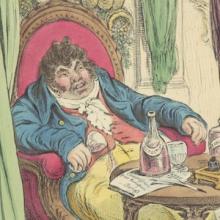
Aristocratic Occupations
The second image, a color drawing by the popular English caricaturist James Gillray in 1805 during the Empire, takes a different view of the Directory, suggesting that it is a time of moral decadence and self–aggrandizement.
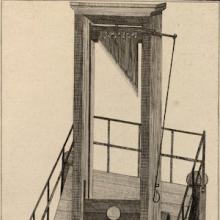
An Ordinary Guillotine
The guillotine was first introduced as a humane, efficient, and above all modern form of execution in April 1792; during the radical phase of the Republic, it would become the symbol of the Terror. This engraving suggests the guillotine is providing "good support for liberty."

Mercator Projection, Eurasia Centered
The map is a Mercator projection that has been altered. Instead of placing North America in the center, the Eurasian land mass is in the middle. This map of the world suggests some of the ways the choices made by mapmakers have a significant impact on our understanding of the world.

Mercator Projection
The map is a Mercator projection and is among the most common in use today. It places North America at the center.
This source is a part of the Analyzing Maps methods module.
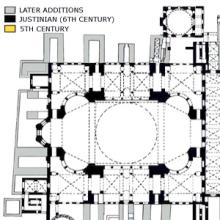
Hagia Sophia Floor Plan
This is an architectural drawing of the Hagia Sophia’s floor plan. Buildings such as the Hagia Sophia offer us wonderful opportunities to investigate such things as evolving religious practices, architectural and engineering techniques, and the relationship between a building and political power.

Hagia Sophia
This an image of the Hagia Sophia, the cathedral of the Byzantine Empire in Constantinople. It was built in the early 6th century by the Emperor Justinian and stands today, almost 1,500 years later, despite earthquakes, wars, and revolutions. The Hagia Sophia began its life as a Christian church, became a Muslim mosque and is now a museum.
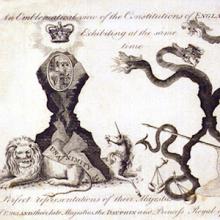
An Emblematical View of the Constitutions of England and France
Similar to the two engravings of trees, this engraving contrasts English order with French anarchy. On the left, a lion (representing England) sits at the foot of a chiseled rock, part of which is labeled "Unanimity." A crown appears over the rock; a unicorn lies behind it. To the right, a multiheaded serpent representing France writhes around a broken flag reading "Anarchy."
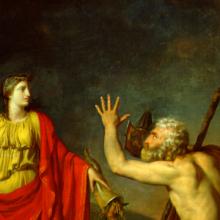
Allegory of Truth
Female revolutionary figures stood for all kinds of qualities and virtues, in this case, "Truth." Women figures appeared so prominently in paintings and engravings because French nouns for the qualities and virtues were usually feminine (Truth = La Vérité). In other words, paintings such as this one did not represent real women; they used allegorical figures to make a more abstract point.
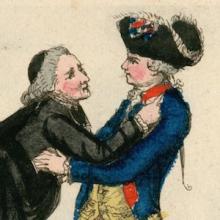
Ah! Monsignor!
Not uncommonly, revolutionary prints invoked excretory humor directed toward those priests who would not swear allegiance to the Revolution. Revolutionaries eliminated on their enemies; the latter might also receive enemas. Of course, in a world of chamber pots everyone got the message loudly and clearly.
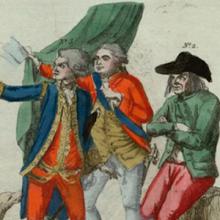
Active Citizen/ Passive Citizen
This cartoon mocks the distinction between active and passive citizens. Many revolutionaries hated this difference, essentially dividing those with property from those without. The propertied (active) were the only ones who could participate in the political process.
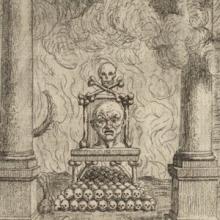
Act of Justice
Here Robespierre’s death is depicted as divine retribution, as in a classical myth.
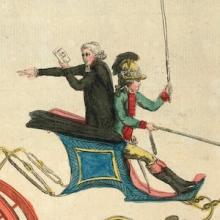
Abuses to Suppress
This print depicts the Third Estate—represented by the peasant at the rear of the chariot, the worker leading the horse, and the merchant driving—delivering to the National Assembly a petition listing "abuses" to be remedied.
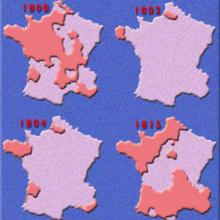
Abstention Rate in Napoleonic Plebiscites
All regions of France did not support Napoleon equally. His rule aroused most enthusiasm in the east (a prerevolutionary border region crucial in the Napoleonic wars) and the center of the country, least in the west, which had long provided a home to royalist counterrevolution.

Women and Stalinism: Drawing, Old Way of Life
Articles and images published in Soviet newspapers on March 8, International Communist Woman’s Day, provide the most obvious examples of how women were used as symbols in a propaganda campaign. These texts and images were clearly intended to convey a certain message about the changing role of women in the Soviet system.
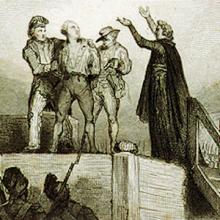
A Positive View?
This composition of the scene, in which a helpless Louis seems to be looking upward to heaven with his confessor, communicates humility. The executioners are relatively passive, leaving the King and confessor center stage. This reveals that in mortal death, the King had a chance to look better than his tormentors.
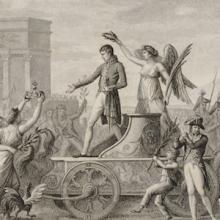
A Grateful France Proclaims Napoleon the First Emperor of the Frence
In this engraving, Roman and contemporary themes are combined to glorify the new emperor. The absence of any clear representation of revolutionary liberty shows Napoleon moving away from the events of the preceding decade.
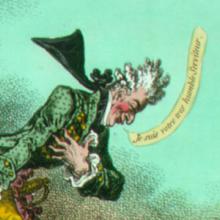
A French Gentleman of The Court of Louis XVI
A sarcastic treatment from England of French manners that contrasts the weakness of the old regime with revolutionary arrogance. The engraver also seems to be pointing toward two entirely different views of masculinity.
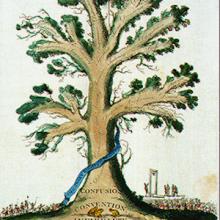
A Foreign Tree
These painted engravings ridicule the unrest wrought by French revolutionaries by contrasting French subversion with British stability.
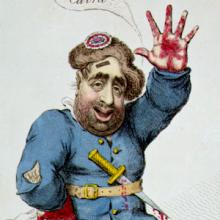
A Democrat, or Reason and Philosophy
This cartoon by the popular British caricaturist James Gillray depicts the British politician Charles James Fox as a sans–culotte. Wearing a cockade in his wig and a bandage on his forehead, the unshaven Fox raises his bloody left hand as he lifts his left leg to break wind. Notice his torn shirt, the bloody dagger in his belt, and the fact that he wears no pants.